
The remains of the Artemis temple in Ephesus, Turkey, one of the seven Wonders of the World (from 600 BCE). (973k)
From the Artemis entry in Wikipedia:
In Greek mythology and religion, Artemis is the goddess of the hunt, the wilderness, wild animals, nature, vegetation, childbirth, care of children, and chastity. She was heavily identified with Selene, the Moon, and Hecate, another moon goddess, and was thus regarded as one of the most prominent lunar deities in mythology, alongside the aforementioned two. She would often roam the forests of Greece, attended by her large entourage, mostly made up by nymphs, some mortals and hunters. The countryside goddess Diana is her Roman equivalent.
In Greek tradition, Artemis is the daughter of the sky god and king of gods Zeus and Leto, and the twin sister of Apollo. In most accounts, the twins are the products of an extramarital liaison. For this, Zeus' wife Hera forbade Leto from giving birth anywhere on land. Only the island of Delos gave refuge to Leto, allowing her to give birth to her children. Usually, Artemis is the twin to be born first, who then proceeded to assist Leto in the birth of the second child, Apollo. Like her brother, she was a kourotrophic (child-nurturing) deity, that is the patron and protector of young children, especially girls, and women, and was believed to both bring disease upon women and children and relieve them of it. Artemis was worshiped as one of the primary goddesses of childbirth and midwifery along with Eileithyia and Hera. Much like Athena and Hestia, Artemis preferred to remain a maiden goddess and was sworn never to marry, and was thus one of the three Greek virgin goddesses, over whom the goddess of love and lust, Aphrodite, had no power whatsoever.
In myth and literature, Artemis is presented as a hunting goddess of the woods, surrounded by her followers, who is not to be crossed. In the myth of Actaeon, when the young hunter sees her bathing naked, he is transformed into a deer by the angered goddess, and then devoured by his own hunting dogs who cannot tell their own master. In the story of Callisto, the girl is driven away from Artemis' company after breaking her vow of virginity, having laid with and been impregnated by Zeus. In certain versions, Artemis is the one to turn Callisto into a bear, or even kill her, for the insolence.
In the Epic tradition, Artemis halted the winds blowing the Greek ships during the Trojan War, stranding the Greek fleet in Aulis, after King Agamemnon, the leader of the expedition, shot and killed her sacred deer. Artemis demanded the sacrifice of Iphigenia, Agamemnon's young daughter, as compensation for her slain deer. In most versions, when Iphigenia is led to the altar to be offered as sacrifice, Artemis pities her and takes her away, leaving another deer in her place.
Artemis was one of the most widely venerated of the Ancient Greek deities, her worship spread throughout ancient Greece, with her multiple temples, altars, shrines, and local veneration found everywhere in the ancient world. Her great temple at Ephesus was one of the Seven Wonders of the Ancient World, before it was burnt to the ground. Artemis' symbols included a bow and arrow, a quiver, and hunting knives, and the deer and the cypress were sacred to her. Diana, her Roman equivalent, was especially worshiped on the Aventine Hill in Rome, near Lake Nemi in the Alban Hills, and in Campania.
All pictures are © Dr. Günther Eichhorn, unless otherwise noted.
Goddess of nature, childbirth, wildlife, the moon, the hunt, sudden death, animals, virginity, young women, and archery.
She is a member of the Twelve Olympians
Various conflicting accounts are given in Classical Greek mythology regarding the birth of Artemis and Apollo, her twin brother. However, in terms of parentage, all accounts agree that she was the daughter of Zeus and Leto and that she was the twin sister of Apollo.
The childhood of Artemis is not fully related to any surviving myth. A poem by Callimachus to the goddess "who amuses herself on mountains with archery" imagines a few vignettes of a young Artemis. While sitting on the knee of her father, she asks him to grant her ten wishes:
Artemis believed she had been chosen by the Fates to be a midwife, particularly as she had assisted her mother in the delivery of her twin brother Apollo. All of her companions remained virgins, and Artemis closely guarded her own chastity. Her symbols included the golden bow and arrow, the hunting dog, the stag, and the moon.
Callimachus then tells how Artemis spent her girlhood seeking out the things she would need to be a huntress, and how she obtained her bow and arrows from the isle of Lipara, where Hephaestus and the Cyclopes worked. While Oceanus' daughters were initially fearful, the young Artemis bravely approached and asked for a bow and arrows. He goes on to describe how she visited Pan, god of the forest, who gave her seven female and six male hounds. She then captured six golden-horned deer to pull her chariot. Artemis practiced archery first by shooting at trees and then at wild game.
The river god Alpheus was in love with Artemis, but as he realized he could do nothing to win her heart, he decided to capture her. When Artemis and her companions at Letrenoi go to Alpheus, she becomes suspicious of his motives and covers her face with mud so he does not recognize her. In another story, Alpheus tries to rape Artemis' attendant Arethusa. Artemis pities the girl and saves her, transforming her into a spring in the temple Artemis Alphaea in Letrini, where the goddess and her attendant drink.
Bouphagos, son of the Titan Iapetus, sees Artemis and thinks about raping her. Reading his sinful thoughts, Artemis strikes him down at Mount Pholoe.
Daphnis was a young boy, a son of Hermes, who was accepted by and became a follower of the goddess Artemis; Daphnis would often accompany her in hunting and entertain her with his singing of pastoral songs and playing of the panpipes.
Artemis also herself taught a man, Scamandrius, how to be a great archer, and he excelled in use of bow and arrow with her guidance.
Broteas was a famous hunter who refused to honor Artemis, and boasted that no thing could harm him, not even fire. Artemis then drove him mad, causing him to walk into fire, ending his life.
According to Antoninus Liberalis, Siproites was a Cretan who was metamorphosed into a woman by Artemis, for, while hunting, seeing the goddess bathing.
Actaeon was a hunter who after returning home from a long day's hunting in the woods, stumbled upon Artemis and her retinue of nymphs bathing in her sacred grotto. The nymphs, panicking, rushed to cover Artemis' naked body with their own, as Artemis splashed some water on Actaeon, saying he was welcome to share with everyone the tale of seeing her without any clothes as long as he could share it at all. Immediately, he was transformed into a deer, and in panic ran away. But he did not go far, as he was hunted down and eventually caught and devoured by his own fifty hunting dogs, who could not recognize their own master.
The story of Niobe, queen of Thebes and wife of Amphion, who blasphemously boasted of being superior to Leto, is very old; Homer knew of it, who wrote that Niobe had given birth to twelve children, equally divided in six sons and six daughters (the Niobids). Other sources speak of fourteen children, seven sons and seven daughters. Niobe claimed of being a better mother than Leto, for having more children than Leto's own two, "but the two, though they were only two, destroyed all those others." Leto was not slow to catch up on that, and grew angry at the queen's hubris. She summoned her children, and commanded them to avenge the slight against her. Swiftly Apollo and Artemis descended on Thebes. While the sons where hunting in the woods, Apollo crept up on them and slew all six or seven with his silver bow. The dead bodies where brought to the palace. Niobe wept for them, but did not relent, saying that even now she was better than Leto, for she still had seven children, her daughters. On cue, Artemis then started shooting the daughters one by one. Right as Niobe begged for her youngest one to be spared, Artemis killed that last one. Niobe cried bitter tears, and was turned into a rock, but Amphion, at the sight of his dead sons, killed himself. The gods themselves entombed them. In some versions, Apollo and Artemis spared a single son and daughter each, for they prayed to Leto for help; thus Niobe had as many children as Leto did, but no more.
Orion was Artemis' hunting companion; after giving up on trying to find Oenopion, Orion met Artemis and her mother Leto, and joined the goddess in hunting. A great hunter himself, he bragged that he would kill every beast on earth. Gaia, the earth, was not too pleased to hear that, and sent a giant scorpion to sting him. Artemis then transferred him into the stars as the constellation Orion.
Callisto, the daughter of Lycaon, King of Arcadia, was one of Artemis's hunting attendants, and, as companion of Artemis, took a vow of chastity.
According to Hesiod in his lost poem Astronomia, Zeus appeared to Callisto, and seduced her, resulting in her becoming pregnant. Though she was able to hide her pregnancy for a time, she was soon found out while bathing. Enraged, Artemis transformed Callisto into a bear, and in this form she gave birth to her son Arcas. Both of them were then captured by shepherds and given to Lycaon, and Callisto thus lost her child. Some time later, Callisto "thought fit to go into" a forbidden sanctuary of Zeus, and was hunted by the Arcadians, her son among them. When she was about to be killed, Zeus saved her by placing her in the heavens as a constellation of a bear.

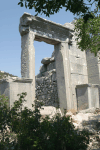
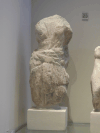
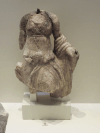

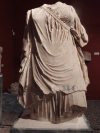

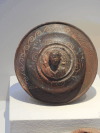

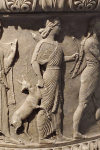


This page contains 12 pictures
Here are the links to the other main pages on Greece:
Page last updated on Fri Aug 19 17:06:50 2022 (Mountain Standard Time)
Artemis on gei.guenther-eichhorn.com